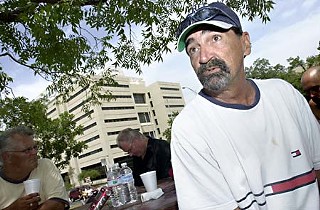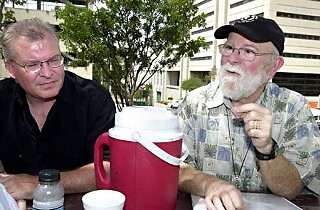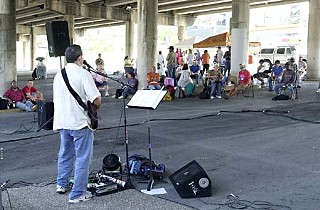Faces of Homelessness
Another Downtown attempt to find answers
By Marc Savlov, Fri., Oct. 9, 2009

First, the good news.
Depending on where in Austin you live, the entertainment district's ongoing woes – among them a slaphappy, punch-drunk summer that just barely missed doing the Berkowitz shuffle and enough radiant heat to make last month's filming of local action auteur Robert Rodriguez's hyperviolent Machete both look and feel like a viva la raza!-themed remake of Do the Right Thing – appear considerably less intractable than they did when we first took a look at Downtown crime earlier in the year ("Crime and the City Solution," Music, June 26).
Make no mistake, it's still a smart idea to keep a can of Mace or pepper spray in your purse, pocket, or high-stylin' D&G messenger bag when you're out and about Downtown. Despite a visible uptick in Austin Police Department bicycle officers and both marked and unmarked patrol cars in the area bordered by Congress Avenue and I-35, 11th Street and Cesar Chavez – and a string of arrests – the situation persistently teeters between friendly, albeit drunken, Sixth Street chaos on a good night and outright assaults (or worse) on a bad one.
In the wake of the area's hottest recorded summer and with the economy still in free fall, Austin's traditional social service buffer zones have been feeling the heat more than ever. The logic of capitalism dictates that the fewer jobs there are, the more citizens will be relying on social safety-net organizations such as Caritas, the Salvation Army, and the Austin Resource Center for the Homeless to keep themselves and their families afloat. Unfortunately, the location of all three major social services outreach groups – smack in the middle of the entertainment district and within a one-block radius of both a major liquor store and the long strip of rowdy, alcohol-fueled nightlife – has inevitably drawn fire from Sixth Street area merchants and stakeholders, pleading, "Not in our front yard."
Yet despite recurrent rumors, the ARCH is not going anywhere. "The city has never had on its agenda, either in official or unofficial capacity," flatly declares City Council Member Sheryl Cole, "moving the ARCH."
Within that context, how best to keep the peace?
Several efforts are in the works, not always in sync, ranging from community meetings to redevelopment to proposed city ordinances. A Downtown Austin community forum was recently held at the Alamo Drafthouse at the Ritz to address the APD's freshly minted "Downtown Quality of Life Enhancement Initiative." The event featured representatives of the department's Downtown Area Command, other city officials, the Downtown Austin Alliance, the Downtown Austin Neighborhood Association, and various stakeholders, business owners, and residents (the next forum is scheduled for Wednesday, Nov. 4, at 3pm). In addition to anti-crime initiatives, the discussion addressed the Downtown Austin Alliance's vision for historic Sixth Street to take part in the city's Great Streets Program – an urban redevelopment effort that would include widening of sidewalks for cafe-style dining, abundant shade-producing trees lining the streets, and a higher concentration of mixed-use retail space alongside existing bars and music venues. While not specifically an anti-crime measure, Great Streets brings in more people at leisure – and a higher number of people is a natural deterrent to crimes of opportunity. More immediately, the DAA is again seeking support for persuading City Council to strengthen the controversial anti-solicitation ordinance – a perennial effort that has garnered both a mixed public response and even more mixed success. (See "The Latest Proposal.")
All these efforts sound promising to anyone who, like me, lives and works Downtown – because, honestly, despite the Downtown Quality of Life Initiative, very little progress has been made when it comes to the district's notoriously difficult problems at the intersection of Homeless Street and Crack Avenue. As a Downtown resident of more than 10 years, I have come to sympathize with merchants' portrayals of late-night drug- and alcohol-related street life as something straight out of The Wire. Thanks in part to an influx of what the APD obliquely describes as "gang-related activity," it is getting sketchy out there, and (anecdotally at least) residents are beginning to get sufficiently edgy to procure concealed firearms. Yet the Downtown homeless, often portrayed as the source of the troubles, are in fact just as likely to be victims of miscellaneous street crime. Whatever the ultimate causes, this is not what city officials or redevelopers had in mind when they reimagined Downtown as a sprawling, tech-centric magnet for the best and the brightest.
The Homeless vs. the Houseless
Despite the common perception of Downtown homelessness as a life of drug and alcohol dependency, panhandling, vagrancy, or "theft by intimidation" (e.g., "watching your car" while you head off to a night spot), there are essentially two distinct homeless populations, with the more disturbed or aggressive (disheveled, violent, or most in need of medical or psychiatric treatment) emerging as the perceived but somewhat misleading face of homelessness. According to "Solutions for Homeless Chronic Alcoholics in Austin," a recently released study co-authored by ARCH Executive Director Helen M. Varty and Knox-Woollard Professional Management:
• Of the approximately 3,451 homeless people in Austin (numbers submitted via a Continuum of Care report from Austin's homeless service providers to the U.S. Department of Housing and Urban Development in 2008 – the actual number may be as high as 5,000), "Austin is short 1,800 units of housing for this population, which represents an unmet need of 52% for the homeless in our community."
• Of those 3,451 individuals, 919 (27%) were considered "chronically homeless" by the HUD report, a term referring to "an unaccompanied homeless individual with a disabling condition who has either been continuously homeless for a year or more, or has had at least four episodes of homelessness in the past three years."
• Although national estimates place the percentage of chronically homeless between 10% and 23% (that is, lower than Austin percentages based on actual counts) of the total experiencing homelessness, this population typically uses half of the available services for the homeless – resources such as shelters, hospitals, emergency rooms, jails, and prisons.
• Finally, of the 3,451 HUD homeless count in Austin, 1,208 were estimated to have some form of alcohol problem, and 875 were estimated to be individuals with chronic substance-abuse problems.
It's the undeniably frightening, wild-eyed face of "chronic homelessness" that's threatening the quality of life and financial stability of Downtown. Nevertheless, that's not the face of the majority of the homeless men and women in Austin – most of whom, through a combination of bad luck or bad decisions, have been missed by the social safety nets (such as they are in Texas) and are struggling to regain a functioning, solid foothold into society-at-large – what most of us take for granted as normal, daily life. To get a better perspective on that population of Austin's homeless, I hooked up with advocate and activist Alan Graham, who in 1998 founded the highly respected Austin-based ministry to the homeless, Mobile Loaves & Fishes.
"Mobile Loaves & Fishes is a faith-based, Christian social outreach ministry," Graham explains. "The mission is: We provide food, clothing, and dignity – heavy emphasis on the dignity – to our brothers and sisters in need. The foundation of that [is] our catering trucks that go out on the streets every night of the week, manned by volunteers serving homeless people where they are. We currently have about 17 of these trucks in six cities around the U.S., including New Orleans and Nashville."
On a hot but shade-comfortable midafternoon in late August, I sit across from Graham and a small group of his homeless friends at a picnic bench in the southwest corner of Wooldridge Square park, just across the way from the great block-and-tackle behemoth that is the Travis County Courthouse. I'm here at Graham's urging; as he sees it, his outreach work with Austin's homeless and indigent community has long been a pivotal indicator of how Austin is doing as a whole.
The half-dozen homeless men and women I meet here aren't anything like the blitzed, aggressive panhandlers who have lately starred in Downtown's combination Bowery Boys six-reeler and law enforcement nightmare. Most of these men and women are either reading books (James Patterson is popular) or genially shooting the breeze, jawing about Texas' hell-hot weather, or simply enjoying the shade under one of the park's magnificent oaks. For sleeping arrangements, a few pitch their tents as far south as Stassney Lane or West Gate Boulevard, coming into the Downtown area to work at steady employment ranging from roofing companies to construction to maintenance gigs. But none of their day jobs straight-pay enough of a living wage to secure and maintain what you and I would call a home: four walls, a roof, first and last months' deposit, plus real-world essentials such as utilities and a phone.
Richard (who, like his companions, asks that I not use his last name) is a stocky Hispanic male in his mid-40s; he lost his job after a heart attack. "I sleep behind the church [nearby] and pretty much just hang out in the park during the day," he begins. "I know a lot of people look down at us because we're homeless, but they need to know that we're homeless for a reason, and not by choice. And we're not doing drugs or this-and-that; we're not bothering nobody, either. I mean, it's hard being homeless. I have heart problems, and I'm waiting for my Social Security Disability Insurance to come through – which is difficult because I'm not always staying in one place, you know? I can get my mail at the ARCH, but I don't like to go down there too much – there's too many dopeheads. You need to watch your back when you go Downtown."
J.D. – a thirtysomething man who, frankly, looks like a typical, laid-back University of Texas grad student – offers specific advice on addressing Downtown's persistent panhandling problems. "One thing that would really help decrease the numbers of homeless in Austin," he tells me, "is if the city could try to raise public awareness of the fact that there's a difference between 'crackheads and alcoholics' and 'homeless people.' Because a lot of the homeless people out here don't consider themselves 'homeless,' they consider themselves 'houseless.' Home is where we go to sleep at night. We just might not have a traditional structure to do it in.
"Another thing the city could do to decrease the numbers of homeless in Austin," J.D. continues, "would be to allow the ARCH to look into people's backgrounds, right? Not necessarily in a 'Big Brother' way, but just to identify if people are repeat offenders or if they've been on the streets for 10 years and all they use the ARCH for is sleeping or washing or eating free food. People who are abusing the system, right? There's plenty of people who are on government assistance and get their checks at the ARCH, but who are right back there three days later because they've smoked it all up. ...
"Granted, there are houseless people who like sleeping outside, and I'm one of them. I'm more content sleeping in the park with good friends and reasonably nice weather than I ever was sleeping in a loft in Dallas. The hardest part of being houseless in Austin right now is the heat. Food is abundant. There's at least 12 places a day that feed people, from the Sally [Salvation Army] if you want really salty food to Caritas, if you prefer soup every day, to Alan and Mobile Loaves & Fishes. I'm thankful for all those places, and I know that the people who run them are doing it out of the goodness of their hearts and sharing their food with us."
As for panhandling specifically, says J.D.: "They should make it illegal. People need to realize they shouldn't give panhandlers money; they should give them information. The only things we need in this life are food, sleep, and a bathroom. There's no reason, especially in Austin, with as many places as there are to eat [free], for anyone to be [panhandling]. If you're [begging for money to eat] in Austin, you're blind, and even I know that, after only five weeks here. The money you give them is going to cigarettes, drugs, or alcohol."
Walking back to my car, Graham stops me and notes: "There's a business to homelessness. There's an economy to this thing. And what I see going on right now is these organizations around the country 'puffing up' what's happening in homelessness, and by puffing up I mean trying to expand the definition of who can be called homeless. They're now including people who are living in their brother's house and sleeping on the couch and floor. I'm not saying that that's a great thing, but I'm saying that if you're 'homeless,' then you're living in places that are not considered habitable by human beings. Your brother's apartment, that's not a bad deal. Your car is. The camp that you live in or the bridge that you live under or the shelter that's not really meant for long-term habitation, that's homeless.
"The camps that I've been looking at for most of my career, if you go into them at 9am, they're empty. The people are gone, they're up, they're out looking for work. They're moving about on their daily basis trying to find food, clothing, work, or whatever their necessities are. This 'tent city' thing that's been cropping up in Portland, Seattle, Nashville – that's not happening here."
And why not?
Graham pauses. "I'm not really sure. I would say that if you look at our chronic homeless population, it's really no more than about 1,000 people, and probably more like 800. So our numbers are just low. And the other [2,400-4,200] are cyclically homeless. There's something that's happened in their life that's put them into economic homelessness, but they're also pretty likely to be in and out of their homeless situation fairly soon. It's a struggle, but at some point in time ...."
Three Things
Yet while even some homeless people say they would outlaw panhandling, other voices say that simply toughening pre-existing anti-panhandling ordinances is little more than a temporary patch on a much larger systemic sinkhole.
Richard Troxell, the die-hard community activist who founded the originally Austin-based, now national, House the Homeless organization in 1989 and who is now the national chair of the Universal Living Wage Campaign, argues that enacting more ordinances against, for instance, sleeping in public areas is just a way, bit by bit, to criminalize homelessness itself. Working out of the ARCH, Troxell provides pro bono legal help for clients there while simultaneously promoting his Universal Living Wage Campaign, which seeks to tie the federal minimum wage – currently pegged at $7.25 an hour – to more reasonable economic indicators. It's a tough argument to make during a nationwide recession.
"We need three things to end homelessness," exhorts Troxell. "We need affordable housing, we need national health care, and we need livable incomes. Livable incomes breaks down into two factions, those who can work and those who can't work. For those who can work, we're promoting the universal living wage, which goes to fix the federal minimum wage, $7.25 an hour, which is currently insufficient to get by on. Our goal is to take it from a federal minimum wage to a universal living wage. Even the U.S. Conference of Mayors, year after year, when asked what the single greatest contributor to homelessness is, says it's the fact that you can work a full-time, minimum-wage job and not be able to afford basic food, clothing, shelter."
As for the Downtown Austin Alliance's anti-solicitation enhancement initiative, Troxell says he's heard it all before. "To hear the DAA frame this thing, one more time, as [not criminalizing homelessness], I mean, let me just say this on record: Let's participate in solving the problem, and let's stop dealing with the symptoms of it in their area. It's very self-serving, and yet it's shortsighted. I've been hearing this for 20 years in Austin, that we need to have this 'no camping' ordinance or this one other ordinance, over and over again. At what point do people not wake up and realize the Downtown businesses are not uniformly, collectively, working to solve this problem? They're working at the symptoms, but they're not working to participate as community members to solve the [underlying problems]."
To the implicit criticism of his members, Charlie Betts of the DAA responds: "Many of the social service agencies are endorsing the strengthening of that ordinance, and we are pairing that with a public relations effort that we are contributing to financially to encourage people to give to social services agencies. We know that money will be going to help people rather than to a panhandler who in Downtown Austin is certainly not panhandling for food, considering the three square meals that are provided to anybody that wants them." Moreover, according to a DAA press release, the anti-solicitation initiative is supported by "approximately 80 representatives from the East Sixth Street area ... Caritas of Austin, the Austin Convention & Visitors Bureau, the Downtown Austin Neighborhood Association, 6ixth Street Austin, Austin Hotel & Lodging Association, the Texas Association of Realtors, and Front Steps' – the ARCH's managing organization – board of directors."
Darla Gay is a community planner with the Travis County District Attorney's Office. A former APD officer, Gay changed tack in midcareer, 12 years ago, "to help expand the whole idea of community prosecution." During her time with APD, Gay was heavily involved in community policing, which emphasizes the neighborhood context in which crime occurs (an approach receiving renewed interest from Austin Police Chief Art Acevedo). Gay works on "collaborative system planning," which she translates as "things that intersect within the system and require bringing stakeholders and organizations together." If this were indeed The Wire, Gay would be a city-level fixer, introducing one key stakeholder to another, getting the gears to mesh, and coaxing the always slow bureaucratic wheels to grind inexorably forward.
Much of Gay's current work addresses Austin's homeless community and, specifically, its alcohol- and substance-dependent subsets – "collecting data which is telling us a story that has never been told," as she puts it. She's anticipating public release of the results later this year.
"One of the big intersections with our office is the homeless issue," Gay says, "and looking at how to solve that problem. Obviously, that's been a problem in Downtown Austin for years, and so we helped to develop the Downtown Community Court, and we've been working on that whole intersection of where the homeless population meets the criminal justice system. What can we do, from a problem-solving mode, other than just enforcement? Most of what the homeless or aggressive panhandlers are being arrested for are class C misdemeanors – nuisance crimes."
She describes one response, the Austin/Travis County Reentry Roundtable, "which has been focusing on the barriers that people have for getting set up for success when they get out of prison or jails, or if they just have a criminal background to deal with. There's a major overlap between prison and jail, homelessness, and the mentally ill, and while some counties may see it as their job to be in the courtroom and get as many convictions as they can, obviously [former District Attorney] Ronnie [Earle] didn't think like that, and neither does [current D.A.] Rosemary [Lehmberg]. We've got to get down to the root causes of homelessness before you can do long-term change, and that's what we're trying to do."
Next Steps
Okay, 512, listen up. Any Downtown histori-gentrifi-makeover of our beloved entertainment district that keeps it economically viable, non-life-threatening, and just a tad seedy (tourists dig slumming so long as it's not down their own block) will be slow going. Which should come as absolutely no surprise to anyone who's been following either Graham's ongoing struggle to secure land for his Habitat on Wheels project ("Homeless RV Park Seeks Good Neighbors," June 27, 2008) or Troxell's noble but quixotic campaign for a universal living wage.
The crux is to keep the right people at the right tables with sufficient momentum to keep on pushing. Tackling the homelessness issue while trying to find a way to improve quality of life for everybody – housed and houseless alike – is tantamount, as virtually everyone interviewed for this article can attest, to saddling a Hydra.
Council Member Sheryl Cole offers some final, challenging words: "I can't emphasize enough that we have to be committed to learning how to do more with less. ... Issues like homelessness cannot just be swept under the rug. We have to be brave enough to address this head-on."
Housing the Homeless
A public forum to address the needs of Austin and Travis County's homeless populations will feature keynote speaker Bill Hobson, who led Seattle's implementation of a Housing First program that now serves as a national model for other cities. The event, sponsored by Criminal Court Judge Nancy Hohengarten, takes place Friday, Oct. 16, 8am-noon, at City Hall.
Got something to say on the subject? Send a letter to the editor.












